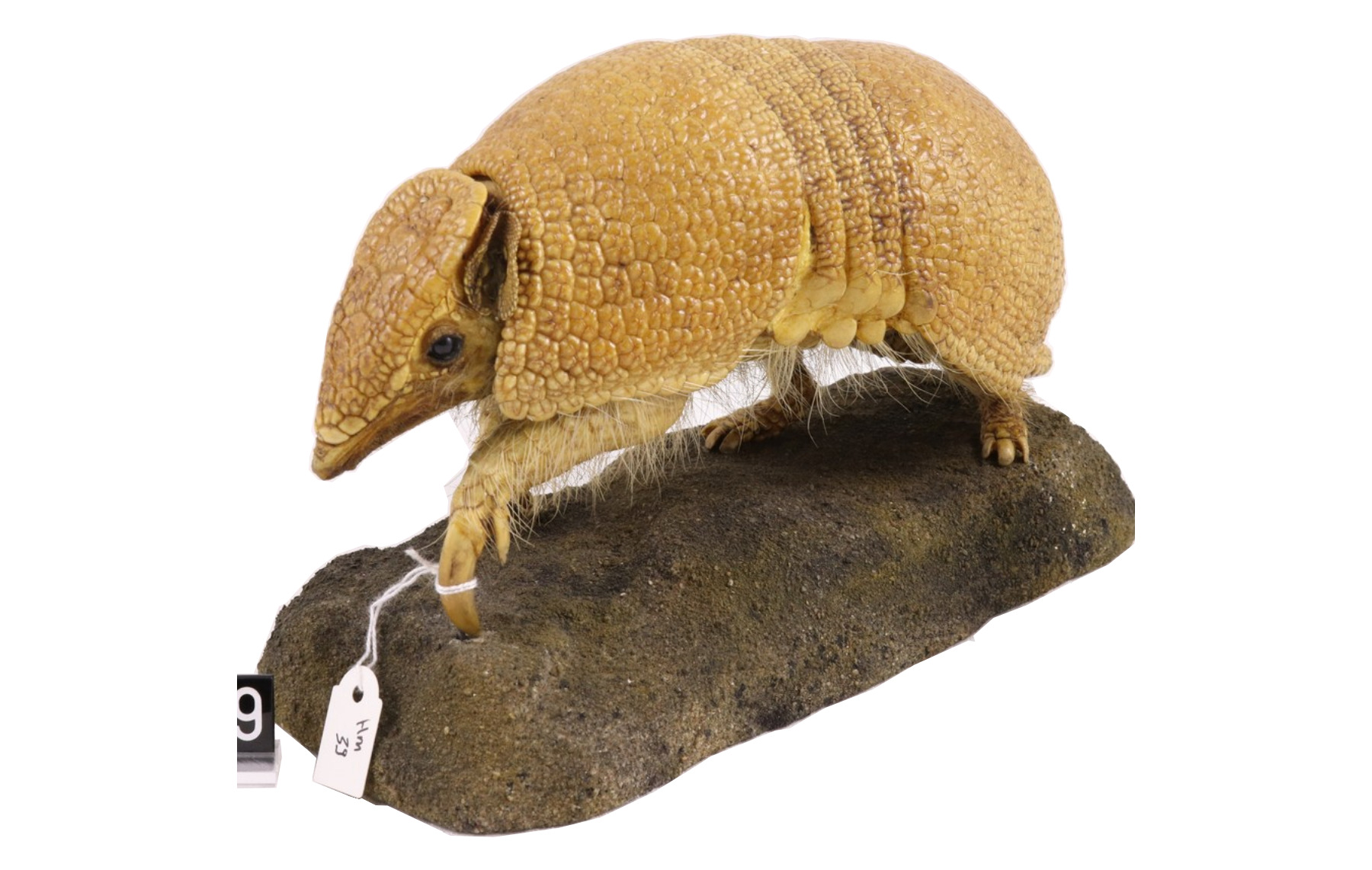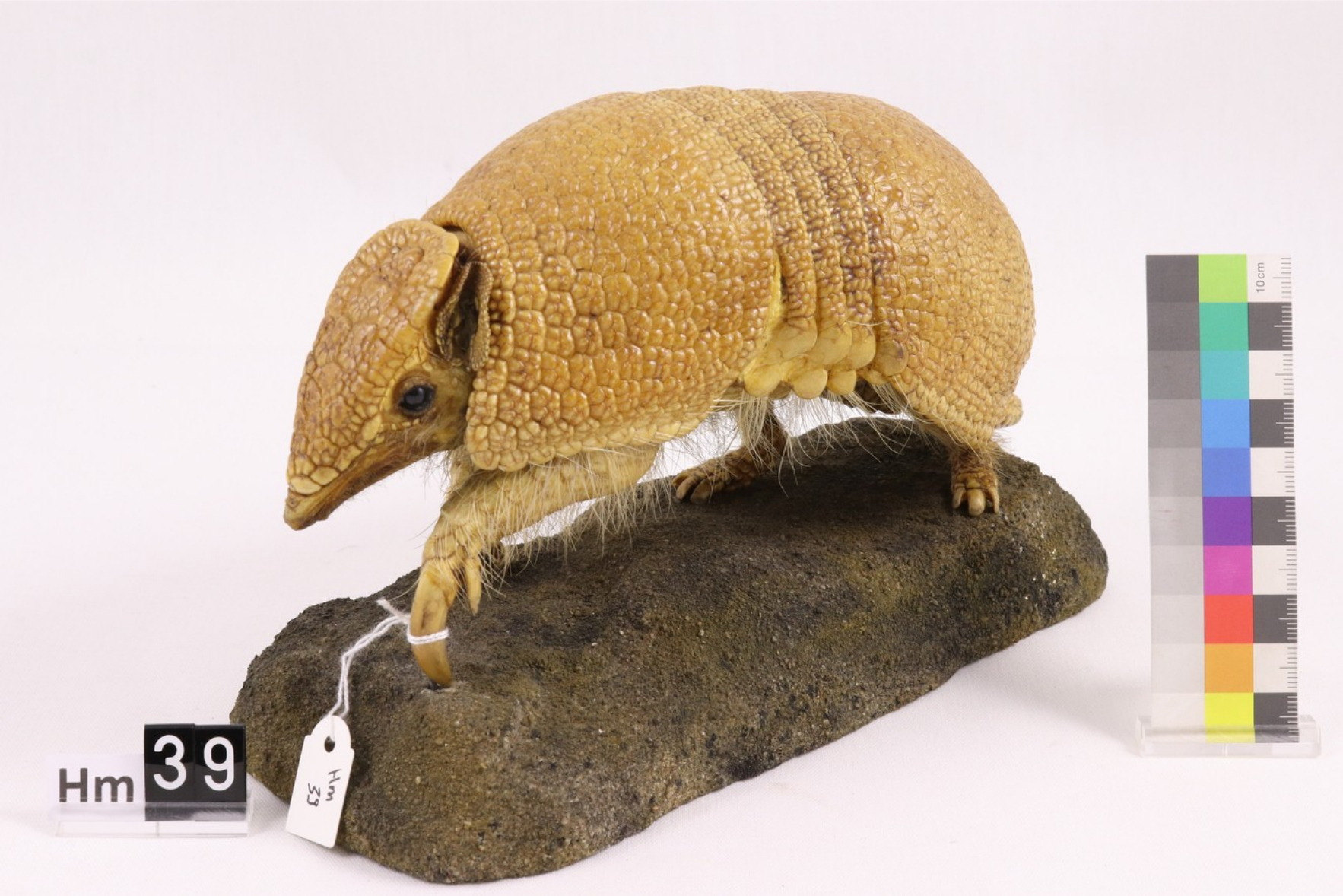An Armadillo from BASA Museum
Beschreibung
In the cold deposit of the BASA museum in Bonn, we found a taxidermized Southern three-banded armadillo (TOLYPEUTES MATACUS). It measures only 21 centimeters in length but this small armadillo is emblematic for the dynamic history of Paraguay in the 20th century. During its lifetime, the armadillo roamed free through the warm, dusty woodlands of the Paraguayan Gran Chaco until it was captured in the early 1960s by the Mennonite teacher and hunter Jakob Unger.
In 1930, German-Russian Mennonites founded the Fernheim colony in Paraguay after having escaped religious persecution in the Soviet Union. The armadillo was specifically prepared in Fernheim for a collector in West Berlin called Walter Hausmann. Hausmann himself never set foot in the Americas, he was a print maker by trade. He set up his own small museum in his family home, featuring artifacts, life and taxidermized animals and exotic plants from his suppliers in Paraguay and Canada. From the 1960s to the 1990s, he maintained correspondence with the Mennonite families Unger and Klassen from Fernheim.
In 2021, over 200 artifacts from Hausmann entered the BASA museum. Hausmann’s personal archive was also acquired. In this archive, we can find a scrap book with articles on the Mennonite colonies and even photos from an encounter between dictator Alfredo Stroessner and Mennonite colonists. Hausmann occasionally wrote for the Mennonite newspaper Mennoblatt, including one article featuring this specimen to discuss the evolution of armadillos from the ancient GLYPTODON.
References:
- Paola Canova (2020): Negotiating Environmental Subjectivities: Charcoal Production and Mennonite-Ayoreo Relations in the Paraguayan Chaco, in: Journal of Mennonite Studies 38, 61-84.
- Walter Hausmann (1962a): Als das Gürteltier noch keinen Gürtel hatte”, in: Jugendblatt 1962/11, 1-2.
-- (1962b): no title [letter to the editor], in: Mennoblatt 1962/21, 8.
- nacht-depeche / N.N. (1967): Eine Brücke in den Urwald. Völkerkundler aus Passion, in: nacht-depeche, 28.03.1967, 8.
- Naomi Rattunde (2020): Donated, Purchased, Inherited, Investigated: Provenance and Potential of New Acquisitions into the BASA Museum, in: Daniel Grana-Behrens / Karoline Noack (eds.): From “Bronze Rooster“ to Ekeko: Impulses toward Ethnological Provenance Research in University Collections and Museums, Bonn: University of Bonn, BASA Museum, 45-58.
In 1930, German-Russian Mennonites founded the Fernheim colony in Paraguay after having escaped religious persecution in the Soviet Union. The armadillo was specifically prepared in Fernheim for a collector in West Berlin called Walter Hausmann. Hausmann himself never set foot in the Americas, he was a print maker by trade. He set up his own small museum in his family home, featuring artifacts, life and taxidermized animals and exotic plants from his suppliers in Paraguay and Canada. From the 1960s to the 1990s, he maintained correspondence with the Mennonite families Unger and Klassen from Fernheim.
In 2021, over 200 artifacts from Hausmann entered the BASA museum. Hausmann’s personal archive was also acquired. In this archive, we can find a scrap book with articles on the Mennonite colonies and even photos from an encounter between dictator Alfredo Stroessner and Mennonite colonists. Hausmann occasionally wrote for the Mennonite newspaper Mennoblatt, including one article featuring this specimen to discuss the evolution of armadillos from the ancient GLYPTODON.
References:
- Paola Canova (2020): Negotiating Environmental Subjectivities: Charcoal Production and Mennonite-Ayoreo Relations in the Paraguayan Chaco, in: Journal of Mennonite Studies 38, 61-84.
- Walter Hausmann (1962a): Als das Gürteltier noch keinen Gürtel hatte”, in: Jugendblatt 1962/11, 1-2.
-- (1962b): no title [letter to the editor], in: Mennoblatt 1962/21, 8.
- nacht-depeche / N.N. (1967): Eine Brücke in den Urwald. Völkerkundler aus Passion, in: nacht-depeche, 28.03.1967, 8.
- Naomi Rattunde (2020): Donated, Purchased, Inherited, Investigated: Provenance and Potential of New Acquisitions into the BASA Museum, in: Daniel Grana-Behrens / Karoline Noack (eds.): From “Bronze Rooster“ to Ekeko: Impulses toward Ethnological Provenance Research in University Collections and Museums, Bonn: University of Bonn, BASA Museum, 45-58.
Kurzbeschreibung
In the cold deposit of the BASA museum in Bonn, we found a taxidermized Southern three-banded armadillo (TOLYPEUTES MATACUS). It measures only 21 centimeters in length but this small armadillo is emblematic for the dynamic history of Paraguay in the 20th century. During its lifetime, the armadillo roamed free through the warm, dusty woodlands of the Paraguayan Gran Chaco until it was captured in the early 1960s by the Mennonite teacher and hunter Jakob Unger.
Typ
TOLYPEUTES MATACUS (three-banded armadillo)
Thema
provenance research, Mennonites, Paraguay, Chaco borreal, taxidermy, object biography
Beteiligte Personen und Organisationen
Obtained by Mennonite teacher and hunter Jakob Unger in the 1960s in the Paraguayan Gran Chaco. Specimen gifted to collector Walter Hausmann in West Berlin. Donated to BASA museum in 2021.
Zeit
1960s
Ort
Paraguayan Gran Chaco
Maße/Umfang
135 (with base) x 210 x 90 mm
Material/Technik
Taxidermized amardillo, stone base
Identifikator
Inventory number: Hm39
Förderung
Project: SciCoMove - Scientific Collections on the Move: Provincial Museums, Archives and Collecting Practices (1800-1950).
Funding: This project has received funding from the European Union’s Horizon 2020 research and innovation programme under the Marie Skłodowska-Curie grant agreement No 101007579.
The contents of this publication are the sole responsibility of the SciCoMove consortium and do not necessarily reflect the opinion of the European Union.
Funding: This project has received funding from the European Union’s Horizon 2020 research and innovation programme under the Marie Skłodowska-Curie grant agreement No 101007579.
The contents of this publication are the sole responsibility of the SciCoMove consortium and do not necessarily reflect the opinion of the European Union.
Dateien


Quellenangabe
„An Armadillo from BASA Museum,” SciCoMove, zuletzt aufgerufen am 1. Juli 2025, https://ausstellungen.deutsche-digitale-bibliothek.de/scicomove/items/show/3.
